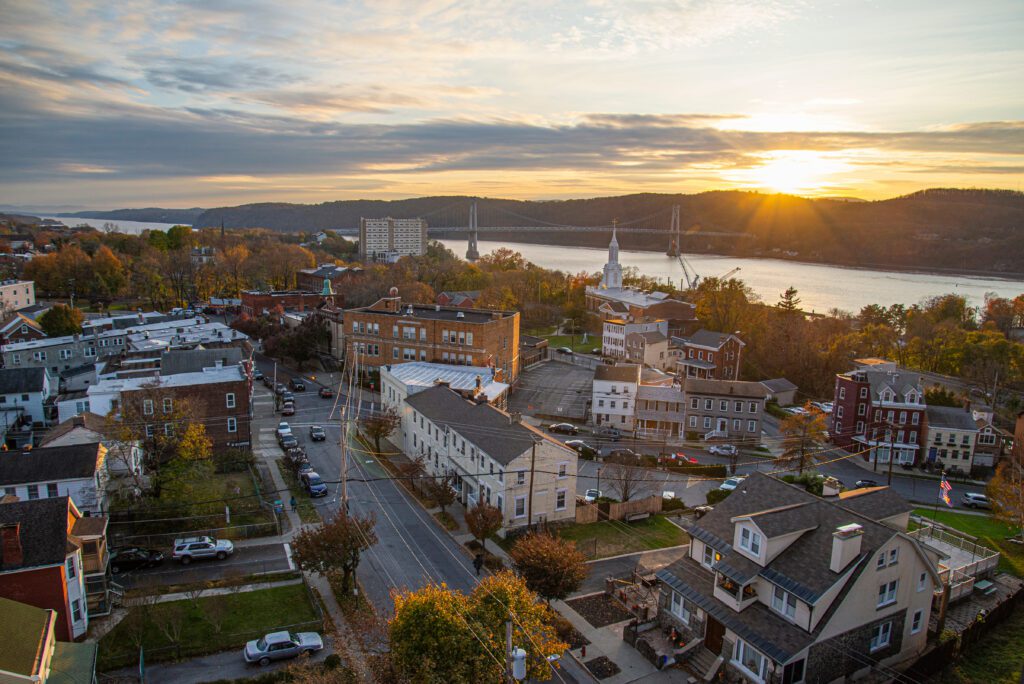Several key factors can determine heat pump size and retrofit feasibility.

New York State has a colder climate and older buildings than much of the country. These realities shape the path to scaling central AC-to-heat-pump swaps across the state.
For any given project, three interrelated factors determine the size of the heat pump and the complexity of the retrofit, which in turn affect cost and feasibility: 1) how much of a home’s heating a heat pump will provide, 2) how cold it gets, and 3) the condition of the building.
1. Heat pump share of heating
A larger heat pump can turn a cooling replacement into a heating system replacement.
When a homeowner replaces a central AC with a heat pump, the retrofit work and future benefits—such as carbon savings—depend in part on the portion of winter heating the heat pump will support.
A heat pump installed to replace an air conditioner is likely a simple drop-in replacement that requires little to no additional work. But in most New York State homes, a heat pump sized only to meet cooling needs won’t meet full winter heating demand. A larger heat pump that offers more heating capacity presents an opportunity to transition the home mostly or completely off a fossil fuel heating system.
That transition will entail higher upfront costs and may require some additional retrofit work like air sealing (as detailed below). But the state has generous incentives for key envelope improvements and heat pump installations that can handle a home’s full heating load, which in many cases can offset most or all of the additional cost.
2. New York State’s cold climate
The colder the winter, the bigger the heat pump.
While almost any central heat pump could meet a home’s summer cooling needs, newer-generation cold-climate air source heat pumps are the equipment of choice for efficient winter heating in climates like New York State. But not all New York winters are created equal, and the local climate will affect the necessary equipment size and retrofit work.
The International Energy Code Council (IECC) designates climate zones based on local weather patterns to inform building design and heating and cooling needs. New York State spans Climate Zones 4, 5 and 6—which are all generally colder—with Climate Zone 4 downstate being the warmest of the three and Climate Zone 6 being the coldest.
Winter heating—and the demand that heat pumps must support—varies significantly across these climate zones. In particular, how often homes experience extremely cold temperatures matters a lot for heat pump size and performance, and for the potential need for backup heating on the coldest days. Generally, AC-to-heat-pump swaps in New York’s warmer climate zones will require a smaller heat pump, a simpler retrofit and no backup heating—all making it easier and less costly to size for full heating replacement.
The map in Figure 2 shows New York’s climate zones, how cold they get, and the total number of homes with central AC in each. It reveals that despite New York’s cold winters, 93 percent of the 2.4 million homes with central AC are located in the warmer zones of the state, making them good candidates for AC-to-heat-pump swaps that can cover most or all of a home’s heating load.
Explore Figure 2 for a deeper dive.
Figure 2
3. Necessary building improvements
Some homes may need weatherization, duct or electrical upgrades.
In homes built or renovated to a modern energy code—and those in the warmest parts of the state—a cold-climate central heat pump may be a drop-in AC replacement that can meet full summer and winter demand. In other homes, AC-to-heat-pump swaps may need to be paired with targeted home improvements so that the new system can meet most or all of a home’s heating needs.
Highest-priority home improvements will ensure that the building envelope is tight and insulated, ducts are adequate and well sealed, and the electrical panel and wiring are sufficient. While these upgrades add time and cost to a retrofit, NYSERDA offers many resources for installers to optimize heat pump performance. Targeted home improvements also save homeowners money by reducing total heating demand, enabling smaller-capacity equipment and lowering winter heating bills.
Figure 3
Tying it all together with the right-sized heat pump
The three factors above—the share of heating provided, how cold it gets and the building condition—all influence the heat pump size needed to heat and cool a particular home. But there is no reliable rule of thumb. The right size for a heat pump depends on many other site-specific factors, including square footage, orientation, layout, building systems and more. And experts caution against oversized heat pumps, which can be costly and reduce comfort.
A typical 1,750-square-foot home in New York State requires a cooling system (whether a central AC or heat pump) with a capacity between 1.5 tons and 3 tons, depending on the climate and condition of the home. But in many New York homes, heating demand on cold winter days will outpace what a heat pump sized for cooling can provide. A bigger heat pump with more capacity (higher tonnage or BTUs) will likely be needed.
Table 1 shows how fully-sized heat pump capacity may vary for a 1,750-square-foot home across the state, even within the same climate zone, depending on those site-specific factors mentioned above.
Table 1
Estimated heat pump size needed to fully heat and cool a 1,750-square-foot home with a semi-tight envelope and ductwork in conditioned spaces of the home 2
| Climate Zone | Estimated heat pump size for year-round heating needs in a 1,750-SF New York State home |
|---|---|
| Zone 4 (❄ Cold) | 2.5 tons – 4 tons |
| Zone 5 (❄❄ Colder) | 3.5 tons – 5 tons |
| Zone 6 (❄❄❄ Coldest) | 4 tons – 5 tons |
Pairing heat pump installations with measures that bring down a home’s total heating load is crucial to enable smaller-sized heat pumps, reduce energy use and lower utility bills. For example, air infiltration of the envelope is often the biggest culprit for a home’s heat loss. In many cases, a knowledgeable service provider can cut that infiltration by up to 50 percent or more. Improving infiltration can help avoid more costly and invasive duct improvements, and deeper measures like adding heat recovery ventilation to the HVAC system can lower total heating loads even more. Equipment needs will vary for each home, and resources like the Pacific Northwest National Labs and federal Department of Energy offer expert guidance on cold-climate heat pump sizing and selection.
